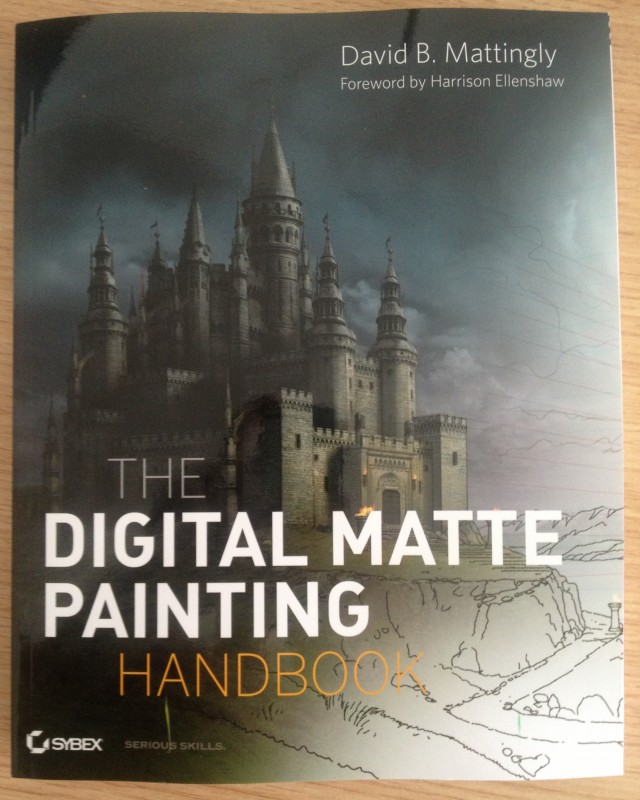En este momento, en el que tanto se está hablando de la industria de los efectos visuales, yo decidí que voy a meterme más en el mundo del Matte Painting.
Me llegó por correo el libro The Digital Matte Painting Handbook de David Mattingly, publicado por Sybex.
Es lo más completo que he encontrado para Matte Painting, porque a diferencia de otras fuentes, no se enfoca únicamente en la parte de photoshop, la recopilación de imágenes y la forma correcta de tratar la perspectiva. Tiene varios capítulos que hablan de la proyección de esas imágenes y cómo deben ser aplicadas a tu software 3D, en este caso, Maya. También hace un ejemplo usando el espacio 3D de After Effects.
Puede ser que no he buscado bien, pero me impresiona la poca información que existe sobre la proyección, hay una gran parte del matte painting que es más que nada, conocimiento, lo cual se transfiere perfecto en texto o un tutorial.
El libro comienza con diseño de brochas en photoshop y te enseña a usarlas, empezando con pintar una nube. Tiene un capítulo sobre composición, para esas personas que llegan a esta etapa y desconozcan de su existencia o importancia. Para mi alivio, usó sección aurea. Digo alivio, porque otros artistas parecieran ignorarlo por completo. Habla extensamente de cómo lograr la perspectiva correcta y cómo deformar las imágenes fuente para que sirvan para la toma. Muestra cómo transformar una escena de día a una escena de noche y cambiar de estación la escena. Termina con un breve uso del chroma key en After Effects.
Tiene también una serie de trucos para todo: qué usar para generar texturas nuevas, cómo modificar correctamente el color de objetos, cómo determinar si la perspectiva está correcta, cómo crear perspectiva atmosférica, qué usar para qué en situaciones en las que es difícil conseguir referencia.
Si deseas informarte más sobre el libro, recomiendo que leas las reseñas de Amazon, especialmente los que le ponen 3 estrellas, que suelen ser los más objetivos. Este libro no es para personas que acaban de abrir Photoshop o Maya por primera vez. Diría que es nivel intermedio.
Voy a empezar a usarlo y te cuento como me va.
Por cierto, el libro está completamente a colores. Por su naturaleza, creo que es necesario, así que si te lo estabas preguntando, la respuesta es sí.
—
In these times, when there’s a lot of talking about the visual effects industry, I decided I’m going to immerse myself in the world of matte painting.
Today, the book The Digital Matte Painting Handbook by David Mattingly, published by Sybex, arrived in my mailbox.
It’s the most comprehensive read I’ve found for matte painting, because unlike other sources, it does not focus solely on the photoshop, the collection of images and the right way to treat perspective part. It has several chapters that speak of the projection these images and how they should be applied to your 3D software, in this case, Maya. It also makes an example using the After Effects 3D space.
I may be lacking internet searching skills, but I am impressed that there seems to be very limited information on matte painting projection, there’s a big chunk of matte painting that is mostly knowledge, which can transfer to text or a tutorial, perfectly.
The book begins with brushes in Photoshop design and teaches you to use them, starting with the painting of a cloud. It has a chapter on composition, for those people who reach this stage, unaware of its existence or its importance. To my relief, he used golden section. I say relief, because other artists seem to disregard this completely. He speaks extensively on how to achieve proper perspective and how to deform the source images for the shot. It shows how to transform a scene from day to night scene and the change of seasons. It ends with a brief use of chroma key in After Effects.
Throughout the book, there’s a number of tricks for all kinds of things: what to use to generate new textures, how to change the color of objects correctly, how to determine whether the perspective is correct, how to create atmospheric perspective, what to use in situations where it is difficult to get reference and so on.
If you want to learn more about the book, I recommend you read the reviews on Amazon, especially those who put 3 stars, which are often the most objective ones. This book is not for people who just opened Photoshop or Maya for the first time. I would say it is intermediate users.
I will start using it and let you know how it goes.
By the way, the book is entirely in color. For its nature, I believe it’s a must, so if you were wondering, the answer is yes.

Lesson: Projection textures in Maya





Comment